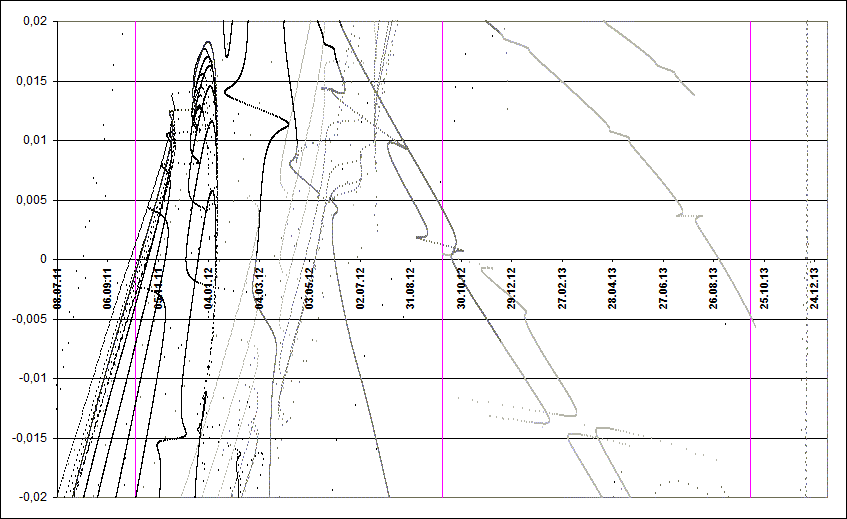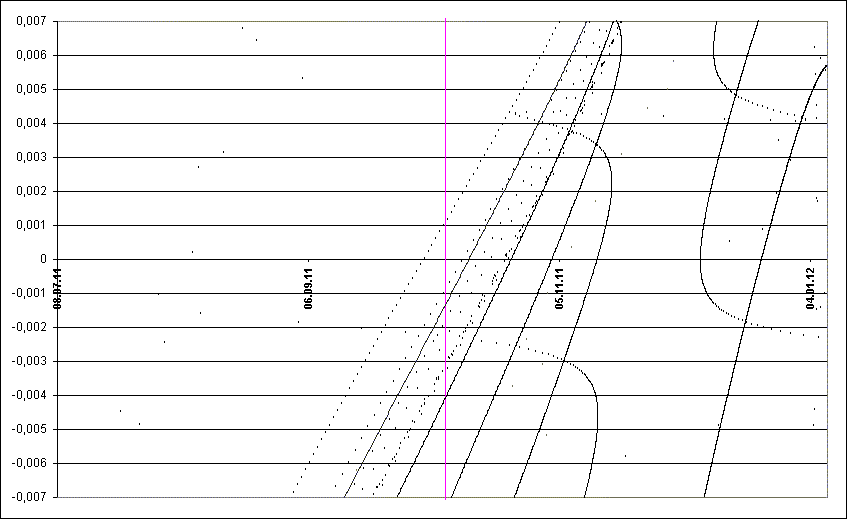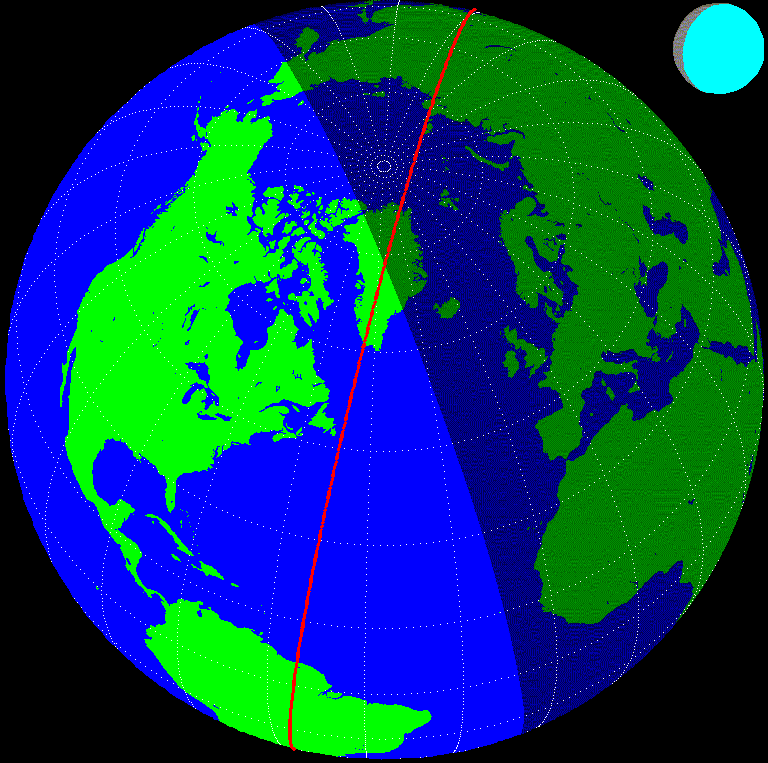Draconids 2011: prediction of activity
to the list of predictions

Fig. 1. Space-temporal projection of Draconids trails parts onto their minimal distance passages dirung the period (correspondence between colours of the particles and their ejection velocities can be seen here).

Fig. 2. Detailed space-temporal projection of Draconids trails parts onto their minimal distance passages in 2011 (correspondence between colours of the particles and their ejection velocities can be seen here).
In 2011 the Earth will get close with a bunch of 1887-1926 trails. There won't be very close encounters, three the most close trails (1887, 1894 and 1900 ones) will pass at -0.00092 AU, +0.00107 AU и -0.00136 AU, respectively. By this reason, I don't expect very high Draconid activity in 2011, with ZHR reaching 40-50 meteors at maximum. The major part of activity is expected to be produced by 1900 trail, which is several times denser than 1887 and 1894 trails. The maximum time for 1900 trail is 20:13 UT 8 October, so far this time is expected to become the time of maximum activity of the overall outburst. Minimum distances to 1887 and 1894 trails will be passed by the Earth several hours before this, at 17:04 and 18:06 UT 8 October, respectively. So far, the first meteors of the outburst are expected to appear already at 17-18 UT 8 October, and their average brightness will be quite high at the beginning, but with the following gradual decrease to the average levels closer to the main maximum time of 20:13 UT. Also, decrease in activity after reaching the maximum levels is expected to be more sharp than its growth. Theoretical rediant of the outburst is: RA=263.3°, Dec=+55.8°, Vg=20.9 km/s. Unfortunately, the sky quality at the expected maximum time will be spoiled by the light of the almost full Moon in the evening time, when the Draconids radiant is in its highest altitudes. However, in the northern hemisphere the Moon will be not very high in the sky.
The Draconids 2011 outburst was predicted by many authors, Jeremie Vaubaillon, Esko Lyytinen, Mikiya Sato, Hartwig Luethen among them. The given prediction is in principal agreement with these works, but its estimation of expected outburst intensity is on the conservative side comparing to them.

Fig. 3. The Earth as seen from coming Draconid meteors (RA=48°, Dec=+58°) during the expected maximum time of outburst from 1887-1900 trails at 20:13 UT 8 October. Red line shows the border of hemisphere where the Moon is above horizon (it is shown with in the corner of the Fig. 3 according to its phase).
As shown on the Fig. 3, the best conditions for this outburst observation will be the Europe and north-western edge of Africa. The reasonable radiant height will be also in the major part of the Middle East and in the northern edge of Eurasia, excluding the extreme north-east. Also, observers in that part of Eurasia will have good conditions to check expected low Draconid activity from 1887 and 1894 trails several hours prior to the main maximum. Very good conditions for radioobservations will be in Nothern America, in the very north of South America the radiant will be also high enough for radioobservations.
References
1. "Comet's dust 2.0" program by S. Shanov and S. Dubrovsky. [Used for orbital computations.]
2. Lyytinen E, van Flandern T. "Predicting the strength of Leonid outbursts", 2000, Icarus, P. 158-160.
3. Jenniskens P. Meteor showers and their parent comets, 2006, 780 p. 4. Kasuo Kinoshita, http://jcometobs.web.fc2.com/ [Orbital elements of the comet 21P Giacobini-Zinner]
References
1. "Comet's dust 2.0" program by S. Shanov and S. Dubrovsky. [Used for orbital computations.]
2. Lyytinen E, van Flandern T. "Predicting the strength of Leonid outbursts", 2000, Icarus, P. 158-160.
3. Jenniskens P. Meteor showers and their parent comets, 2006, 780 p. 4. Kasuo Kinoshita, http://jcometobs.web.fc2.com/ [Orbital elements of the comet 21P Giacobini-Zinner]